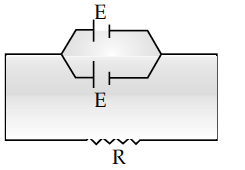Two identical cells, each of emf E, having negligible internal resistance, are connected in parallel with each other across an external resistance R. What is the current through this resistance ?

Since internal resistance is negligible, so total resistance = R
Potential difference across the resistance = E.
Hence, current through the resistance in the circuit :
Two cells of emfs 1.5 V and 2.0 V having internal resistances 0.2Ω and 0.3Ω respectively are connected in parallel. Calculate the emf and internal resistance of the equivalent cell.
Plot a graph showing the variation of current I versus resistance R, connected to a cell of emf E and internal resistance r.
A 10 V battery of negligible internal resistance is connected across a 200 V battery and a resistance of 38Ω as shown in the figure. Find the value of the current in the circuit.
Two electric bulbs P and Q have their resistances in the ratio of 1 : 2. They are connected in series across a battery. Find the ratio of the power dissipation in these bulbs.
Two cells of E.M.F. 10 V and 2 V and internal resistances 10 Ω and 5 Ω respectively, are connected in parallel as shown. Find the effective voltage across R.
Two cells of emfs E₁ & E₂ and internal resistances r₁ & r₂ respectively are connected in parallel. Obtain expressions for the equivalent.
(i) resistance and
(ii) emf of the combination
A cell of emf 4 V and internal resistance 1 W is connected to a d.c. source of 10 V through a resistor of 5 W. Calculate the terminal voltage across the cell during charging.
Why is the use of ac voltage preferred over dc voltage ? Give two reasons.
Nichrome and copper wires of same length and same radius are connected in series. Current I is passed through them. Which wire gets heated up more ? Justify your answer.
Show variation of resistivity of copper as a function of temperature in a graph.
Two dipoles, made from charges ± q and ± Q respectively, have equal dipole moments. Give the
(i) ratio between the ‘separations’ of these two pairs of charges,
(ii) angle between the dipole axes of these two dipoles.
A 10 V battery of negligible internal resistance is connected across a 200 V battery and a resistance of 38Ω as shown in the figure. Find the value of the current in the circuit.
State which of the two a capacitor or an inductor, tends to become SHORT when the frequency of the applied alternating voltage has a high value.
